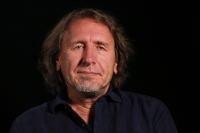He worked as a laborer, exhibiting works of forbidden artists in his spare time

Stáhnout obrázek
He was born in 1952 in Ústí nad Labem. He grew up in Šumperk, where in August 1968 he watched the arrival of Polish tanks. He trained as a machine toolman, got married and in 1978 moved with his family to Prague. There he met people from the Jazz section and actively collaborated with them. After the banning of the Jazz Section, he found a room in the foyer of the Opatov Cultural Center, in which he began to organize exhibitions of artists who could not exhibit elsewhere. A total of 111 of them took place, in addition to the openings, there were also meetings of writers and other cultural events. Samizdat „jednolisty“ (a single paper) with texts by leading theorists were also published at the exhibitions. Some of the events were banned by the authorities, but the gallery functioned intermittently until 1992. After that, Jaroslav Krbůšek operated the Gallery called Ruce and from 1995 he ran the Václav Špála Gallery. In 1989, he was also tried by the communist regime for reading his reaction to the proclamation of the corporate committee on the anniversary of the so-called Victorious February at a working meeting in TOS Hostivař, where he was employed. His fellow workers defended him, and several of them were briefly detained with him. In October 1989, he was acquitted by a court.

